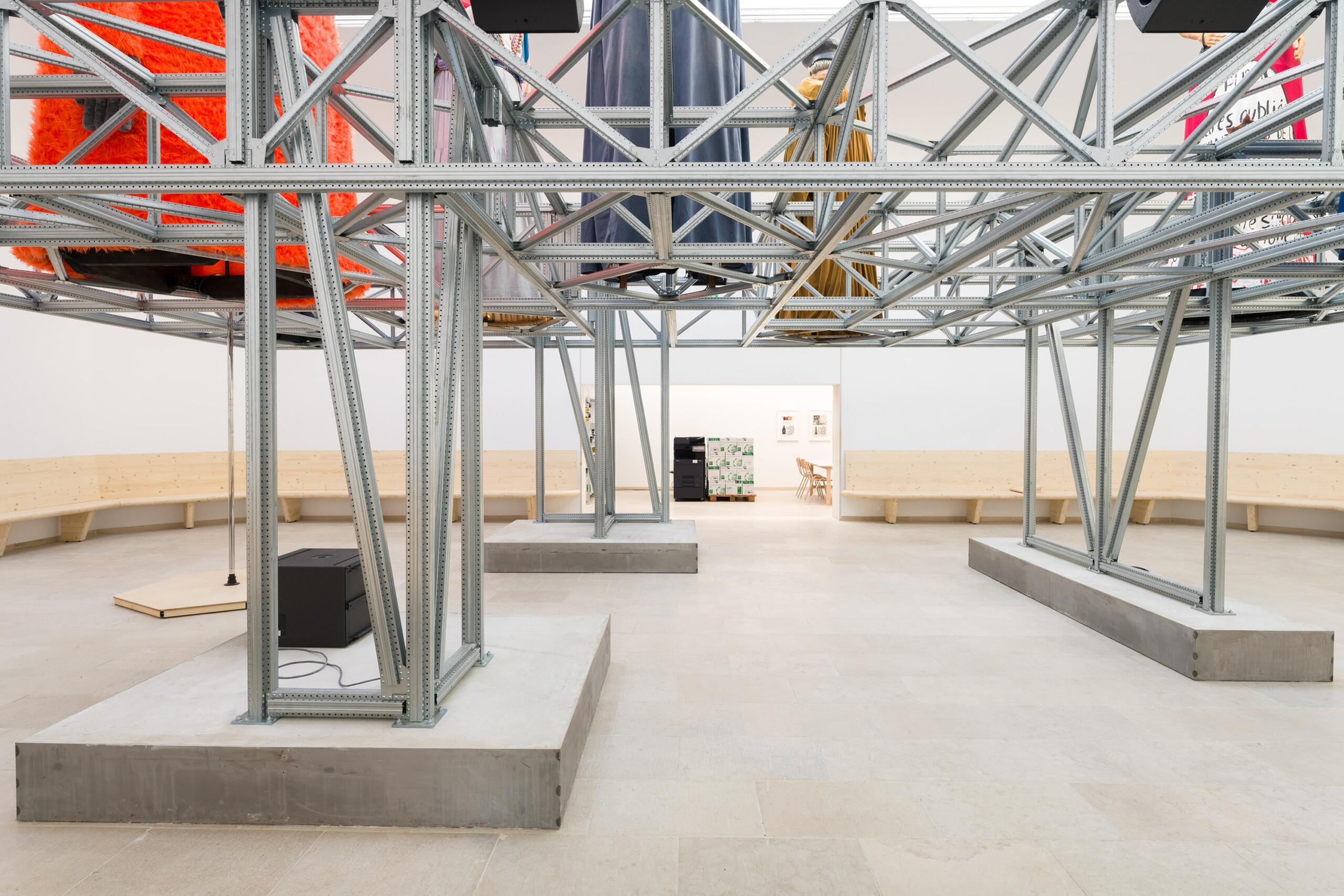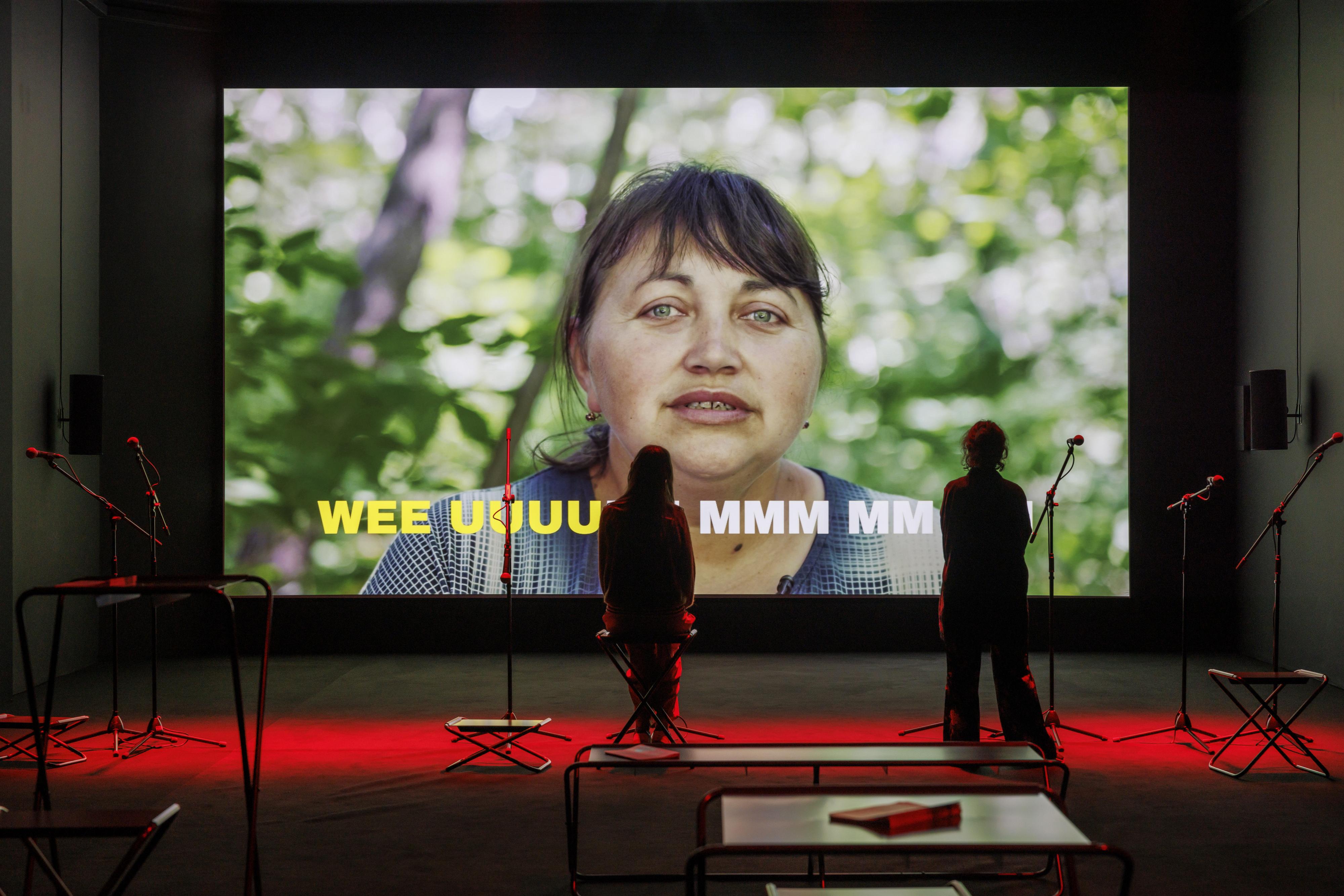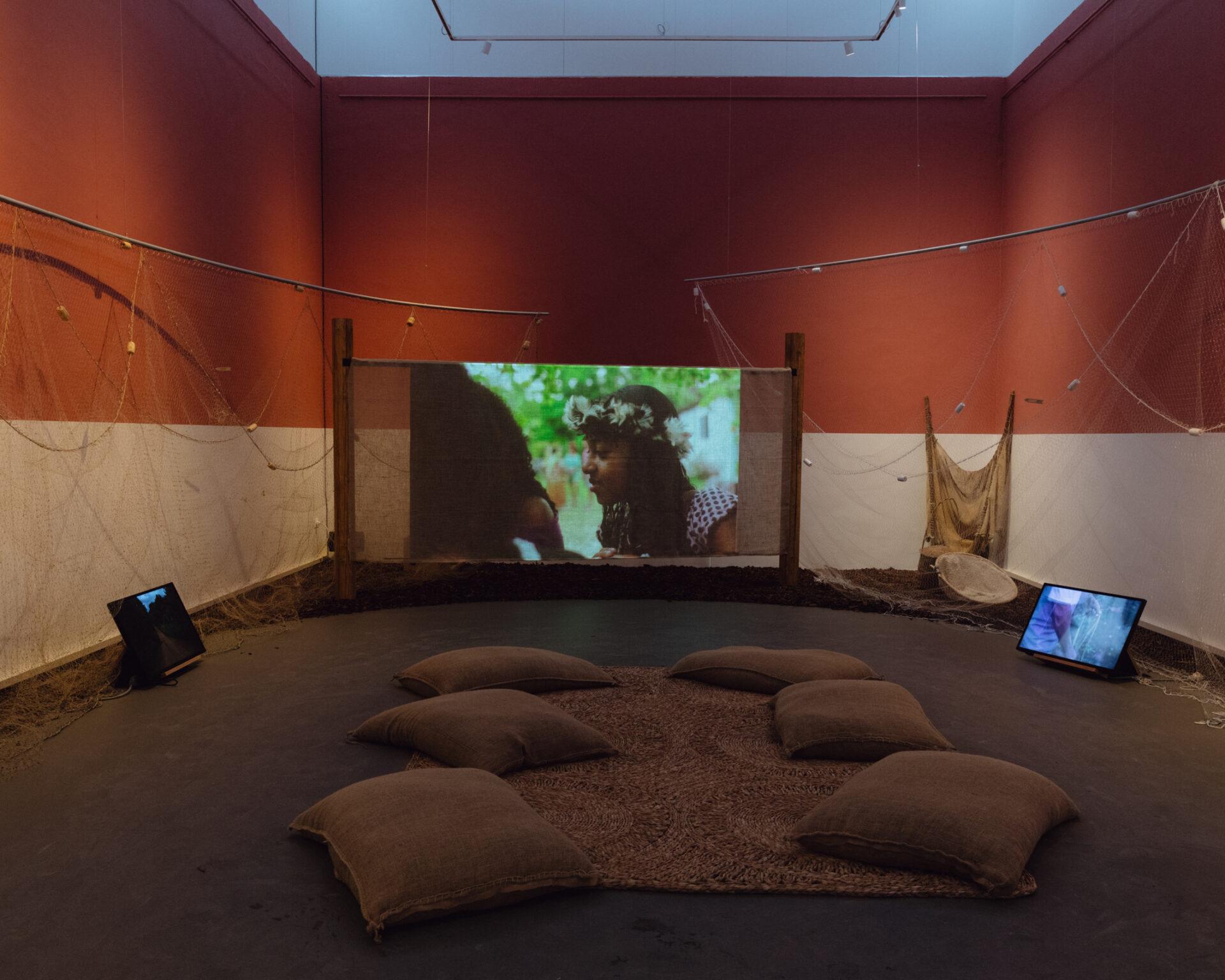
Petticoat Government, Belgian Pavilion at Biennale Arte. Photo by Lola Pertsowsky.
In an article series published on Frame’s blog, invigilators of the Finnish Pavilion in the Venice Biennale write about various topics related to this year’s Biennale. Elmo Holopainen reflects how various national pavilions approach the Biennale’s theme Stranieri Ovunque – Foreigners Everywhere.
This year the theme of the Venice Biennale is Stranieri Ovunque – Foreigners Everywhere. Many of the participating countries have had their own spin on the theme. Still, during my visits to approximately 100 different country pavilions, I noticed two major patterns in the approaches the exhibitions had taken.
One approach is to bring foreigners together, drawing from the idea of the biennale bringing people physically together. Examples of this are the Belgian and the Croatian exhibitions with very communal premises. In many pavilions, a common multi-sensory visitor experience enhances this. For example, exhibitions by France, Ivory Coast and Poland use scent, touch and sound as major elements alongside the visual presentation.
Another prevalent approach focuses on an excluded group of people, often looking at the histories of the countries in question. Here the ‘foreigner’ is understood as an excluded, forgotten, or mistreated group or aspect of life. For example, the Dutch, Nigerian, and US pavilions, take this approach in their exhibitions.
Common experiences
The Belgian exhibition Petticoat Government by a collective of Sophie Boiron, Valentin Bollaert, Simona Denicolai, Pauline Fockedey, Pierre Huyghebaert, Antoinette Jattiot and Ivo Provoost was a sublime and bizarre experience at first. In the pavilion, loud percussion music is surprising and overwhelming. A lot of the sublime feeling came from the music but also from the enigmatic set up inside the pavilion. The space itself is peculiar as it seems to be quite empty and plain with only metal frames and a printer breaking up the emptiness of the pavilion. As you go further you see that the frames lift giant human figures above the visitor. The first room is full of magazines almost like a magazine shop selling only one kind of magazine. What is this strange magazine shop and why is there music? What are these strange human figures?
As you read more about the exhibition you learn about the figures and their histories; they are giants and part of festivities in their respective localities in Europe. They have traveled from different European towns to the Belgian pavilion. The music invites the visitors to dance with each other and the giants. The exhibition is a celebration, bringing together different festivals and visitors. All of us who were, and might still be, foreign to each other. The exhibition is also displaying unity in the form of flags. Different-shaped flags on one side of the pavilion remind us that flags are a very universal element of communal and local celebrations. People all over the world use them and you might identify a familiar shape. We are them for others, but in reality, we are the same. And every human has an urge to celebrate. We all have the ability to sense and even the ways we celebrate can be very similar to a stranger. The foreigner is like us.
Another staggering example of an exhibition that brings the sensory to its largest potential is the Polish pavilion. It shows how observing multi-sensorial art can create a joint experience and behavior. The exhibition Repeat after Me II by Open Group consisting of the artists Yuriy Biley, Pavlo Kovach and Anton Varga invites visitors to a karaoke presenting a video of people who have experienced the war between Russia and Ukraine. These people, projected into a large screen before seats and mic stands, invite us to produce the same sounds that they repeat: sounds that mimic war machines, alarms and bombs they have heard in real life. At the same time, we can see their faces, varying from apathy to desperation, right in front of us. We could have a strong bodily experience by chanting the sounds ourselves and hearing them bounce in the room by different voices as a terrifying choir. Yet few people dare to try to make these sounds. The ones who do, chant them as whispers. The invitation seems to be more of a challenge. As if the artwork, and the people in it, are asking: Do you dare to make this sound with me?

Forgotten things
A frequent approach amongst this year’s national presentations, including Brazil, Denmark and the United States, is to raise awareness about indigenous groups suppressed in history. This way they give a voice to people who are foreigners inside their own country. Ka’a Pûera: we are walking birds in the Brazilian pavilion (renamed as ‘Hãhãwpuá’ pavilion) consists of art pieces by the Indigenous artist Glicéria Tupinambá, who worked in collaboration with her local community, Olinda Tupinambá and Ziel Karapotó; installations with natural materials and videos showcasing traditions.
The works are representing the indigenous values and ways of thinking. The exhibition makes you think about how these often bear great similarities within the different Indigenous groups around the world. They also differ greatly from the way Western societies function: societies where respect for nature feels forgotten and everything new is seen as desirable. Ka’a Pûera refers to a type of cropland but also to a bird that camouflages within the forest floor. The exhibition focuses on the connection with the environment that the people of the Tupinambá Community have. It emphasises their ways of using nature as the base for action and tradition as a value in itself.
The exhibition was a reminder of the struggles that the indigenous peoples face with the past and present colonialist processes all over the world. It brought to mind the various pleads these groups have directed to the local, national and world leaders throughout the years. To let nature coexist or even thrive with us. The growing worry about the environment and the hope that the use of fewer resources during the COVID-19 pandemic evoked came to mind. Even the waters in Venice cleared up when the number of tourists and transportation dropped.
Many exhibitions in the Biennale draw attention more to the colonialist histories of the Western countries. For example, exhibitions by Canada, the Netherlands and Spain discuss their histories outside of their current borders. The Dutch exhibition The International Celebration of Blasphemy and The Sacred by the collective Cercle d’Art des Travailleurs de Plantation Congolaise is one of the most effective. It displays the atrocities in the Congolese plantations formerly owned by the British-Dutch company Unilever. The explicit works done by local Congolese artists are from materials exported from the area as colonial goods.
Other exhibitions such as the Nigerian pavilion discuss colonialist themes and their impacts from the viewpoints of areas colonised by Western powers. Many collateral events also have a focus on this approach. The Africa Center and Open Society Foundations have an event where the visitor can experience the process of applying for citizenship of an imaginary Pan-African union. However, with no direct African descent, the application for the passport will fail.

Glicéria Tupinambá, Dobra do tempo infinito (Fold of Infinite Time), 2024. Photo: Matteo de Mayda
Combination of the two
Some national pavilions like Finland and Ivory Coast touch upon both of the approaches discussed here. The Finnish pavilion exhibition The pleasures we choose by Pia Lindman, Vidha Saumya and Jenni-Juulia Wallinheimo-Heimonen consists of artworks strongly connected to the personal experiences of the artists, addressing for example, hate speech towards disabled people and unconventional healing methods.
The exhibition proposes that artists who choose the pleasure of art creation over other ways of life, better supported by our current societies, can be seen practicing activism just through their life choices. Through these choices, they become almost foreign in a society that promotes busy and wealth-driven ways of life.
This soft activism along with its communal factors is seen also in the setup of the pavilion. Contrary to the full and busy atmosphere of the biennale, where people intend to see as much as possible, the exhibition and its seating allow the visitors to stay for longer and rest. The art has a strong connection to the daily life and the common experiences that many people have. The display of universal elements like waiting in line and stains reminds us of attitudes and experiences that people all over share. Such as the will to erase a dirty stain. Thus even our personal experiences can be shared. There is a touch of them in what we do.
Experiences and reminders
The exhibitions of the country pavilions are a curious mixture of togetherness and separation. The foreigners are everywhere; in our history and our daily lives. Some are forgotten in the process of drifting away from traditions and knowledges. Some are willingly taken out of focus to hide errors, wrongdoings and inequality. And some we just never really thought about.
There is so much in common in all of us that the foreigner is never fully a stranger. We should remember what we have excluded and re-evaluate our society through them. We can have joint experiences together. From senses to minds, we have so much of the same.
– Elmo Holopainen
Student; Exhibition invigilator, Pavilion of Finland
This blog is a platform for reflecting work, current issues and discussions in arts by Frame staff members and other contributors. This blogpost is publisheed in English.
